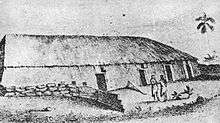Kawaiahaʻo Church
| Kawaiahaʻo Church | |
|---|---|
|
Kawaiahaʻo Church is known as the "Westminster Abbey of Hawaiʻi": site of royal inauguration, christenings, funerals and tomb. | |
| Location |
957 Punchbowl Street Honolulu, Oʻahu, Hawaiʻi |
| Country | United States |
| Denomination | United Church of Christ |
| Website |
www |
| Architecture | |
| Status | Church |
| Functional status | Active |
| Style |
Neoclassical Mediterranean Revival |
| Years built | 1836–1842 |
| Administration | |
| Division | Hawaii Conference |
| Clergy | |
| Pastor(s) | Curt Pa‘alua Kekuna (kahu) |
|
Kawaiahao Church and Mission Houses | |
 | |
| Location | 957 Punchbowl Street and 553 S. King Street, Honolulu, Hawaii |
| Coordinates | 21°18′15″N 157°51′28″W / 21.3043°N 157.8579°WCoordinates: 21°18′15″N 157°51′28″W / 21.3043°N 157.8579°W |
| Area | 8.8 acres (3.6 ha)[1] |
| Built | 1836-1842 |
| Architect | Hiram Bingham |
| NRHP Reference # | 66000294 |
| Significant dates | |
| Added to NRHP | October 15, 1966[2] |
| Designated NHL | December 29, 1962[3] |
Kawaiahaʻo Church is a historic Congregational church located in Downtown Honolulu on the Hawaiian Island of Oʻahu. The church, along with the Mission Houses, comprise the Hawaiian Mission Houses Historic Site, which was designated a U.S. National Historic Landmark (NHL) in 1962.[1][3] In 1966 it and all other NHLs were included in the first issuance of the National Register of Historic Places.
At one time the national church of the Hawaiian Kingdom and chapel of the royal family, the church is popularly known as Hawaiʻi's Westminster Abbey. The name comes from the Hawaiian noun phrase Ka wai a Haʻo (the water of Haʻo), because its location was that of a spring and freshwater pool in the care of a High Chiefess Haʻo.[4]
Today, Kawaiahaʻo continues to use the Hawaiian language for parts of the service. It is one of the oldest standing Christian places of worship in Hawaiʻi, although four thatched churches stood at or near the present site before construction of the stone church. The oldest standing church is Mokuaikaua Church on the Big Island. Denominationally, It is a member of the United Church of Christ.
History

Kawaiahaʻo Church was commissioned by the regency of Kaʻahumanu during the reigns of Kamehameha II and Kamehameha III. Designed by Rev. Hiram Bingham in the New England style of the Hawaiian missionaries, it was constructed between 1836 and 1842 of some 14,000 thousand-pound slabs of coral rock quarried from an offshore reef on the southern coast of Oʻahu. Hawaiian divers with hand tools dived 3 to 6 metres below sea-level to chisel out each coral block, which had then to be transported from the reef and onto shore.[5]
It rivaled the concurrent construction of the Cathedral of Our Lady of Peace for the Roman Catholic Apostolic Vicariate of the Hawaiian Islands. Construction began on that church in 1840 and was substantially completed in 1843, one year after the completion of Kawaiahaʻo Church.
The name Kawaiahaʻo was not applied to the site until 1853.
Kawaiahaʻo Church was frequented by the chiefs of the Hawaiian Islands as well as the members of the reigning Kamehameha Dynasty and Kalākaua Dynasty. The upper gallery of the church is adorned with 21 portraits of Hawaiian royalty (Aliʻi).[6] King Lunalilo, who preferred to be buried in a church cemetery rather than the Royal Mausoleum, is buried in the courtyard.
However, Kawaiahaʻo Church was not the only site of royal worship in the Islands. Kamehameha IV and his wife Emma were devout members of the Church of England and established the Anglican Church of Hawaiʻi, which evolved into the present-day Episcopal Diocese of Hawaiʻi after the islands gained statehood. They commissioned the construction of the Cathedral Church of Saint Andrew, which replaced Kawaiahaʻo Church as the principal centre of royal worship. Kamehameha V, Kalākaua and Liliʻuokalani (after the Overthrow) preferred to utilize the cathedral. Before her reign, then Princess Liliʻuokalani had been choir director at Kawaiahaʻo Church.

List of Kahus (pastors)
- Rev. Hiram Bingham (1820–1840)
- Rev. Richard Armstrong (1840–1848)
- Rev. Ephraim Weston Clark (1848–1863)
- Rev. Henry Hodges Parker (1863–1917)
- Rev. Akaiko Akana (1918–1933)
- Rev. William Kamau (1934–1940)
- Rev. Edward Kahale (1937–1957)
- Rev. Abraham Akaka (1957–1984)
- Rev. William H. Kaina (1984–1997)
- Rev. James Fung (2000-2002)
- Rev. Curtis P. Kekuna (2004–)
References
- 1 2 Benjamin Levy (August 1978). "National Register of Historic Places Inventory-Nomination: Kawaiahao Church and Mission Houses" (PDF). National Park Service. Retrieved 2009-06-22. and Accompanying eight photos, exterior and interior, from 1962 (2.79 MB)
- ↑ National Park Service (2007-01-23). "National Register Information System". National Register of Historic Places. National Park Service.
- 1 2 "Kawaiahao Church and Mission Houses". National Historic Landmark summary listing. National Park Service. Retrieved 2008-07-03.
- ↑ W.D. Westervelt, Hawaiian Legends of Old Honolulu, Boston: G.H. Ellis Press: 1915, p. 17
- ↑ About Kawaiahaʻo Church - History
- ↑ The Aliʻi of Hawaiʻi at Kawaiahaʻo Church
External links
| Wikimedia Commons has media related to Kawaiahaʻo Church. |
- Official site
- Historic American Buildings Survey (HABS) No. HI-14, "Kawaiahao Church, Punchbowl & King Streets, Honolulu, Honolulu County, HI", 19 photos, 10 measured drawings, 15 data pages, 2 photo caption pages
- HABS No. HI-15, "Lunalilo's Tomb, Punchbowl & King Streets (Kawaiahao Churchyard), Honolulu, Honolulu County, HI", 9 photos, 6 measured drawings, 15 data pages, 1 photo caption page

